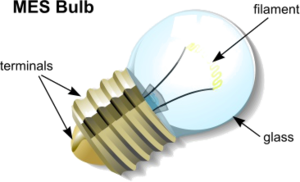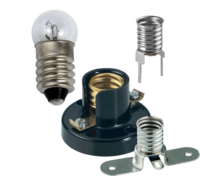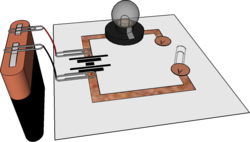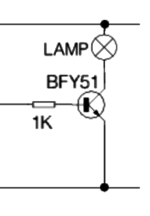Light Bulb: Difference between revisions
From DT Online
m (Added text) |
m (Added application) |
||
| (2 intermediate revisions by the same user not shown) | |||
| Line 1: | Line 1: | ||
[[File:MESbulb. | [[File:MESbulb.png|300px|right]] | ||
__TOC__ | |||
=====Description===== | |||
[http://en.wikipedia.org/wiki/Incandescent_light_bulb '''Bulbs'''] are used as a form of illumination or indication and the type commonly used has a filament coil which glows white hot when a current passes through it. The filament is in a space filled with an inert gas to aid light output and to prevent oxidisation of the filament | [http://en.wikipedia.org/wiki/Incandescent_light_bulb '''Bulbs'''] are used as a form of illumination or indication and the type commonly used has a filament coil which glows white hot when a current passes through it. The filament is in a space filled with an inert gas to aid light output and to prevent oxidisation of the filament | ||
[[File:BulbHolders.png|200px|right]] | |||
Bulbs consume more power than '''[[Light Emitting Diode|LEDs]]''' but give a high light output. There are two common types of bulb used in schools [http://en.wikipedia.org/wiki/Edison_screw#Types '''MES'''] and [http://en.wikipedia.org/wiki/Edison_screw#Types '''LES'''] - which are smaller in physical size than MES types. | =====Features and Applications===== | ||
Bulbs consume more power than '''[[Light Emitting Diode|LEDs]]''' but give a high light output. There are two common types of bulb used in schools [http://en.wikipedia.org/wiki/Edison_screw#Types '''MES'''] and [http://en.wikipedia.org/wiki/Edison_screw#Types '''LES'''] - which are smaller in physical size than MES types. | |||
Mains electric light bulbs may be [https://en.wikipedia.org/wiki/Bayonet_mount bayonet] or screw cap using the larger [https://en.wikipedia.org/wiki/Edison_screw '''Edison Screw (ES)'''] fitting, but screw types are more common for low voltage torch bulbs. These can be mounted using a variety of bulb holders as shown. | |||
| Line 9: | Line 20: | ||
The current rating on the bulb determines the amount of current the bulb will draw used at its correct voltage rating. The higher the current the brighter the bulb will glow (and shorter the battery life will be). Clear glass bulbs are the most common but coloured glasses are available as are flashing bulbs but at a higher cost. Bulbs are usually screwed into a bulb holder which incorporates terminals for connecting wires and to aid in the physical mounting. | The current rating on the bulb determines the amount of current the bulb will draw used at its correct voltage rating. The higher the current the brighter the bulb will glow ''(and shorter the battery life will be)''. Clear glass bulbs are the most common but coloured glasses are available as are flashing bulbs but at a higher cost. Bulbs are usually screwed into a bulb holder which incorporates terminals for connecting wires and to aid in the physical mounting. | ||
[[File: BulbCircuit.png |250px|right]] | |||
=====Light Bulbs in Simple Circuits===== | |||
A torch bulb mounted in a bulb holder can be connected directly to a suitable size battery using wire, copper tape or any other electrical conductor ''(e.g the metal torch body itself)''. Unlike '''[[Light Emitting Diode|LEDs]]''', torch bulbs can be connected into the circuit either way round. | |||
Batteries should be chosen which match the voltage printed on the side of the bulb base ''(commonly 3.5V to 6V)''. A battery too small will result in a dim light and too big will shorten the bulb life. | |||
---- | |||
<span style="color: blue">'''Activity:'''</span> | |||
* <span style="color: blue">Try connecting two bulbs or more together in the circuit one after the other. What happens to the light level? ''(This is called connecting in [https://en.wikipedia.org/wiki/Series_and_parallel_circuits '''Series'''])''. </span> | |||
* <span style="color: blue">Try connecting two or more bulbs together in the circuit side by side. What happens to the light level? ''(This is called connecting in [https://en.wikipedia.org/wiki/Series_and_parallel_circuits '''Parallel'''])''</span> | |||
---- | |||
[[File:Lamp.png|150px|right]] | |||
=====Light Bulbs in Transistor Circuits===== | |||
Incandescant lamps contain a filament inside an evacuated glass bulb. As the current passes through the filament, it heats up and emits light. | |||
Be sure to choose a light bulb that matches the supply voltage of your circuit, and does not draw too much current for the '''Transistor''' you have chosen. | |||
<div style="clear: both;"></div> | |||
{{Bulbs & LEDs Buyers Guide}} | |||
[[Category:Primary]] | [[Category:Primary]] | ||
[[Category:Secondary]] | [[Category:Secondary]] | ||
[[Category:Electronics | [[Category:Electronics Components]] | ||
Latest revision as of 12:58, 2 November 2016
Description
Bulbs are used as a form of illumination or indication and the type commonly used has a filament coil which glows white hot when a current passes through it. The filament is in a space filled with an inert gas to aid light output and to prevent oxidisation of the filament
Features and Applications
Bulbs consume more power than LEDs but give a high light output. There are two common types of bulb used in schools MES and LES - which are smaller in physical size than MES types.
Mains electric light bulbs may be bayonet or screw cap using the larger Edison Screw (ES) fitting, but screw types are more common for low voltage torch bulbs. These can be mounted using a variety of bulb holders as shown.
The voltage and current rating is usually stamped on the side of the body of the bulb. The voltage rating of bulbs in normal use are 2.5, 3.5, 6 and 12V. The correct voltage rating must be used although there is a certain amount of leeway. For example a 6V bulb could be run from a 4.5 volt battery but with reduced light output. Also a 6 volt battery could run a 3.5V bulb causing it to glow brighter and with likely shorter life.
The current rating on the bulb determines the amount of current the bulb will draw used at its correct voltage rating. The higher the current the brighter the bulb will glow (and shorter the battery life will be). Clear glass bulbs are the most common but coloured glasses are available as are flashing bulbs but at a higher cost. Bulbs are usually screwed into a bulb holder which incorporates terminals for connecting wires and to aid in the physical mounting.
Light Bulbs in Simple Circuits
A torch bulb mounted in a bulb holder can be connected directly to a suitable size battery using wire, copper tape or any other electrical conductor (e.g the metal torch body itself). Unlike LEDs, torch bulbs can be connected into the circuit either way round.
Batteries should be chosen which match the voltage printed on the side of the bulb base (commonly 3.5V to 6V). A battery too small will result in a dim light and too big will shorten the bulb life.
Activity:
- Try connecting two bulbs or more together in the circuit one after the other. What happens to the light level? (This is called connecting in Series).
- Try connecting two or more bulbs together in the circuit side by side. What happens to the light level? (This is called connecting in Parallel)
Light Bulbs in Transistor Circuits
Incandescant lamps contain a filament inside an evacuated glass bulb. As the current passes through the filament, it heats up and emits light.
Be sure to choose a light bulb that matches the supply voltage of your circuit, and does not draw too much current for the Transistor you have chosen.










